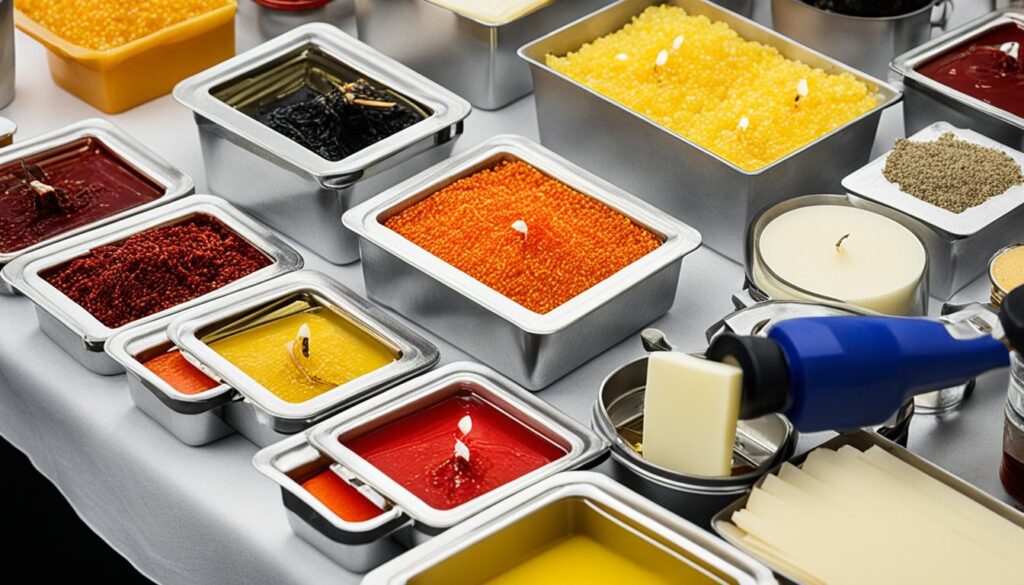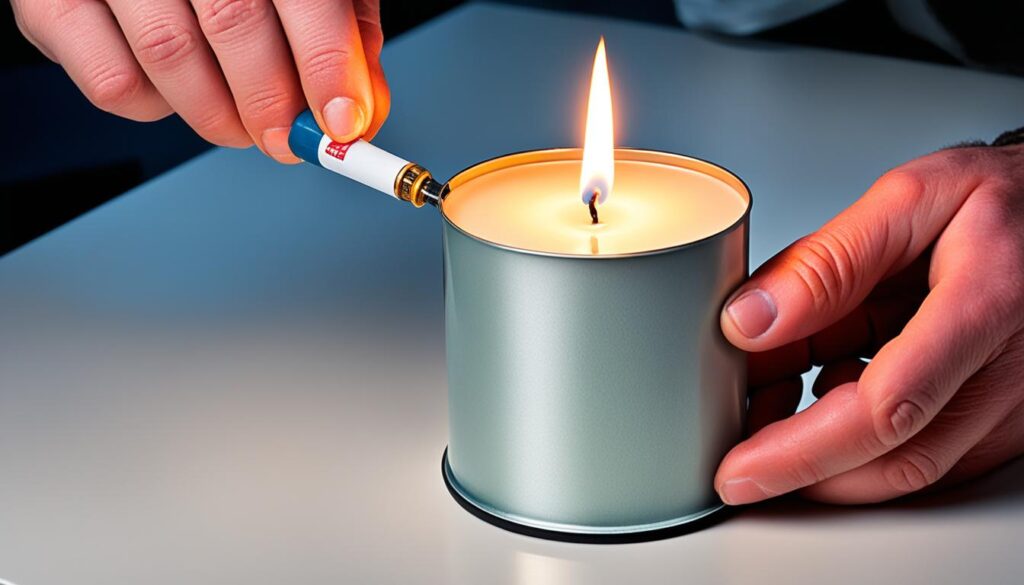Candle Making Safety Tips Every Beginner Should Know
Making candles can be a fun hobby, but safety comes first, whether you’re new or experienced. This guide will share key candle safety tips. These tips help you make beautiful candles safely. You’ll learn how to pick the right materials and care for your candles.
Picture this: you’ve made your first batch of candles, but one of them starts a small fire. It’s a sad moment to see your work go up in smoke. That’s why it’s important to know about candle making safety. With the right steps, your candles will be both beautiful and safe for everyone.
Key Takeaways
- Prioritize safety in every step of the candle-making process
- Select non-toxic waxes and high-quality wicks to ensure a safe burn
- Set up a well-ventilated workspace to prevent fire hazards
- Use proper equipment and protective gear when handling hot wax
- Properly label and store your handmade candles for optimal safety
Choose the Right Materials for Safe Candle Making
When making candles at home, picking safe, non-toxic materials is key. Go for natural waxes like coconut wax. They burn clean, last longer, and don’t produce much soot. Stay away from paraffin wax because it can give off harmful fumes.
Opt for Non-Toxic Waxes and High-Quality Wicks
Picking the right wax and wick is vital for candle safety. Natural waxes, like non-toxic candle wax, are better than paraffin wax. They don’t release harmful compounds when lit. Also, choose high-quality candle wicks made for candle making to ensure a steady and safe burn.
Avoid Paraffin Wax and Substandard Materials
Don’t use paraffin wax or other substandard materials for candles. Paraffin wax can release harmful paraffin wax concerns. This can make your candles less safe and lower their quality. Pick candle making materials safety by going for non-toxic, high-quality options. This will make candle making safer and more fun.
| Material | Characteristics | Safety Considerations |
|---|---|---|
| Coconut Wax | – Clean burn – Long-lasting fragrance – Minimal soot production |
– Non-toxic – Environmentally friendly |
| Paraffin Wax | – Inexpensive – Easy to work with |
– Can release harmful fumes – Not environmentally friendly |
“Investing in high-quality, non-toxic materials is the foundation for safe and enjoyable candle making.”
Set Up a Well-Ventilated Candle Making Area
Creating beautiful candles needs a well-ventilated space. Before starting, make sure your area is well-ventilated. This is key for well-ventilated candle making and keeping you safe, especially when indoor candle making safety matters.
To make a proper candle making workspace, follow these tips:
- Choose a spot that’s bright and has good airflow, away from drafts and busy areas.
- Make sure there’s enough air movement, like through open windows, fans, or a vent system.
- Don’t work in tight, closed spaces that can fill up with fumes quickly.
- Keep your work area clean and free from anything that could catch fire.
- Have a fire extinguisher nearby, just in case.
With a well-ventilated candle making area, you can safely enjoy making candles. A safe, comfy space is key for making great, indoor candle making safety candles you’ll be proud of.
“Proper ventilation is the key to a successful and safe candle-making experience.”
| Ventilation Recommendations | Benefits |
|---|---|
| Open windows or doors | Promotes air circulation and removes fumes |
| Use an exhaust fan | Actively pulls in fresh air and expels hot, stale air |
| Dedicated ventilation system | Ensures a consistent, controlled airflow for the workspace |
Candle Making Safety Tips for Handling Hot Wax
Handling hot wax safely is key in candle making. Keeping the wax at the right temperature is vital. It helps prevent accidents and keeps your candles safe.
Avoid Overheating the Wax
Don’t let the wax get too hot. It’s dangerous and can ruin your candles. Always check the melting point for your wax type. Keep an eye on the temperature to stay within safe limits.
Use Proper Equipment and Protective Gear
Good equipment is a must for safe wax handling. Use a thermometer to check the wax’s temperature. Choose containers and tools that can handle heat. Also, wear protective gear for candle making, like heat-resistant gloves, to avoid burns or spills.
| Equipment | Purpose |
|---|---|
| Thermometer | Accurately measure wax temperature to ensure candle wax temperature control |
| Heat-resistant containers | Safely hold and pour hot wax |
| Sturdy stirring utensils | Mix and blend wax and additives without risk of breakage |
| Heat-resistant gloves | Protect hands from burns during candle making equipment safety |
Follow these safe wax handling tips and use the right gear. This way, you’ll have a safe and fun time making candles.
Prevent Wax Spills and Burns
When making candles, keeping wax spills and fire safety in mind is crucial. It’s important to keep flammable materials away from your work area. This ensures a safe candle-making experience.
Keep Flammable Materials Away
Accidental wax spills can easily set off things like paper towels, curtains, or loose clothes. This can lead to serious fire hazards. To avoid this, keep your workspace clean and organized. Here are some safety tips:
- Make sure your work area is well-ventilated and free from flammable materials.
- Have a fire extinguisher ready for emergencies.
- Wear heat-resistant gloves when handling hot wax.
- Avoid loose clothing or jewelry that could catch fire.
By following these steps, you can safely enjoy making candles. This way, you’ll prevent wax spills and burns.

“Candle making is a creative and rewarding hobby, but it’s crucial to prioritize safety throughout the process.”
Candle Making Safety Tips for Fragrance Oils
When making scented candles, it’s key to pick fragrance oils made for candle-making. These oils work well with heat and wax, giving a steady and safe scent. Also, be sure to add the fragrance oil at the right temperature. Adding it at the wrong temperature can affect the candle’s quality and safety.
Choose Fragrance Oils Suitable for Candles
Not all fragrance oils are the same for candle making. Choose oils made for candles and tested for heat and wax safety. These oils mix well with the wax, giving a strong scent throughout the candle’s life.
Add Fragrance at the Right Temperature
Adding fragrance oil to melted wax at the right temperature is key for candle safety and quality. Always follow the maker’s instructions, as different waxes and oils need different temperatures. Wrong temperatures can cause poor scent, uneven distribution, or even fire hazards.
| Candle Fragrance Oil Safety Tips | Fragrance Oils for Candle Making | Adding Fragrance to Candles |
|---|---|---|
|
|
|
By following these safety tips, you can make scented candles that are both beautiful and safe for everyone.
Test and Cure Your Candles Before Use
Before you share your handmade candles, make sure to test them. This ensures they burn well and safely. Testing helps you fix any issues before giving them to customers. Also, let your candles cure for 24-48 hours before lighting them. This step lets the fragrance fully mix into the wax, making the scent stronger when you burn them.
When testing your candles, light them and watch for at least an hour. Look for uneven burning, too much soot, or tunneling. If you see any problems, adjust the wick or wax mix for your next batch. Curing your candles is key too. It makes the wax hard and the scent strong, giving your customers a better experience.
“Proper testing and curing are the keys to creating safe, high-quality candles that your customers will love.”
By using these safety tips, you can be sure your candles are ready and will burn well for your customers.
Curing and Testing Checklist
- Conduct a burn test for at least 1 hour, monitoring for even burning, minimal sooting, and proper wick performance
- Allow candles to cure for 24-48 hours before lighting to let the fragrance fully develop
- Make any necessary adjustments to wick length or wax blend based on burn test results
- Ensure candles are properly labeled and stored before distribution
| Curing Time | Fragrance Strength | Burn Quality |
|---|---|---|
| 24-48 hours | High | Consistent, even burn |
| 1-2 weeks | Maximum | Optimal |
Candle Making Safety Tips for Proper Labeling and Storage
When making candles, it’s important to focus on safety. This includes proper labeling and storage. If you’re giving or selling your candles, make sure to include safety instructions. This keeps your customers safe and shows you care about making candles responsibly.
When labeling your candles, list the materials, burn time, and any risks. Also, tell your customers how to burn the candle safely. Give them guidelines on how long to burn it and how close to flammable things to keep.
Storing Candles Safely
Storing candles safely is key. Candles should be kept in a cool, dry place away from direct sunlight and heat sources. This keeps the wax, wicks, and fragrances in good condition, making sure your candles stay as they should.
- Don’t store candles in damp or humid places, as this can cause wax blooming and wick damage.
- Keep candles away from windows, radiators, and other heat sources to prevent melting or warping.
- Think about using airtight containers or cabinets to protect your candles from dust, pests, and other environmental factors.
By following these candle labeling safety and safe candle storage tips, you can make sure your candle-making meets the highest safety standards. Your customers will notice the effort you put into their safety, making your candles even more appealing.
Maintain Your Candles for Optimal Safety
Keeping your candles safe and enjoyable is key. A big part of this is trimming the wicks regularly. This keeps soot away and makes the burn cleaner and more efficient. Also, how you store your candles can make them last longer and lower the risk of fires.
Trim Wicks Regularly
Always trim the wick before lighting your candle to about 1/4 inch. This makes the flame burn evenly and stops mushrooming. It’s a simple step that helps your candles last longer and burn safely.
Store Candles Properly
Store your candles in a cool, dry spot away from sunlight and heat. Heat and UV rays can melt the wax, causing it to deform and increase fire risk. Keeping them stored right also keeps their scent and quality strong for longer.
By following these candle maintenance tips, your candles will last longer and be safer. Focus on wick trimming and safe candle storage. This makes your candle-burning experience better and more sustainable.

Conclusion
By following these comprehensive candle making safety tips, you can make beautiful, safe candles. These candles will have lovely scents and are made with great care. Always put safety first in candle crafting. This makes the process fun and rewarding for you and your customers.
Using the candle safety best practices from this guide will help you make safe candles with confidence. You can be creative while keeping yourself and others safe. Follow these tips to become a pro at candle making safety.
Knowledge is powerful, and it makes your candle making journey inspiring and safe. With these important safety tips, you can keep making candle crafts safely. This lets you enjoy the process without worry.
FAQ
What are the essential safety considerations when making candles?
How can I ensure I’m using the right materials for safe candle making?
Why is a well-ventilated workspace important for candle making?
How can I safely handle hot wax during the candle-making process?
What precautions should I take to prevent wax spills and fires?
How do I ensure my scented candles are safe to use?
What steps should I take to prepare my candles for safe use?
How can I maintain my candles for optimal safety?
Source Links
- https://kalamazoocandle.com/blogs/learn-about-candles/candle-making-tips-tricks – 15 Candle Making Tips and Tricks (For Beginners)
- https://www.craftcoconutcandles.ca/blog/mastering-the-craft-our-guide-to-coconut-candle-making-1/candle-safety-tips-every-maker-should-know-4 – Candle Safety Tips Every Maker Should Know
- https://journalnow.com/video_0cb05630-4896-5a3e-9f28-cc573014cc5c.html – Candle making tips every beginner should know
- Fragrance That Wows: A Beginner’s Guide to Adding Scents to Your Homemade Candles
- best essential oils for candles
- wood wick guide
- how to make candles smell stronger
- how to ship candles
- how to fix soy wax frosting
- wick Guide how to choose the right wick size with chart
- how to make candle molds
- how to clean candle wax
- how to reuse candle jars
- soy wax candle troubleshooting
- best wax melter for candle making
- how to conduct burn test
- why candle flickering crackling smoking
- how much wax per candle
- how to make candles smell stronger
- Easy Ways to Increase the Scent Throw of Your DIY Candles
- How to Make Candles for Meditation and Relaxation
- Using Upcycled Materials in Candle Making
- How to Make Hand-Poured Candles: Tips and Techniques

Leave a Reply